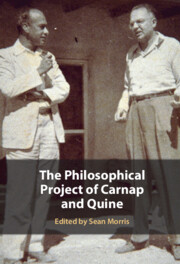22 results
Chapter 1 - Collingwood and Logical Positivism
- from Part I - Situating Collingwood: Beyond Idealism
-
-
- Book:
- Interpreting R. G. Collingwood
- Published online:
- 22 November 2024
- Print publication:
- 05 December 2024, pp 15-25
-
- Chapter
-
- You have access
- HTML
- Export citation
11 - Methodological Revolution
- from Part II - Theory Assessment
-
- Book:
- The Inexact and Separate Science of Economics
- Published online:
- 25 May 2023
- Print publication:
- 08 June 2023, pp 277-301
-
- Chapter
- Export citation
Chapter 7 - Reading Quine’s Claim that Carnap’s Term “Semantical Rule” Is Meaningless
- from Part III - Carnap and Quine on Logic, Language, and Translation
-
-
- Book:
- The Philosophical Project of Carnap and Quine
- Published online:
- 18 February 2023
- Print publication:
- 23 February 2023, pp 135-153
-
- Chapter
- Export citation
Chapter 2 - On Quine’s Guess about Neurath’s Influence on Carnap’s Aufbau
- from Part I - Carnap, Quine, and Logical Empiricism
-
-
- Book:
- The Philosophical Project of Carnap and Quine
- Published online:
- 18 February 2023
- Print publication:
- 23 February 2023, pp 32-51
-
- Chapter
- Export citation
Chapter 11 - Carnap and Quine on Ontology and Categories
- from Part IV - Carnap and Quine on Ontology and Metaphysics
-
-
- Book:
- The Philosophical Project of Carnap and Quine
- Published online:
- 18 February 2023
- Print publication:
- 23 February 2023, pp 215-234
-
- Chapter
- Export citation
Chapter 13 - Carnap, Quine, and Williamson
- from Part IV - Carnap and Quine on Ontology and Metaphysics
-
-
- Book:
- The Philosophical Project of Carnap and Quine
- Published online:
- 18 February 2023
- Print publication:
- 23 February 2023, pp 253-271
-
- Chapter
- Export citation
Chapter 8 - What Does Translation Translate? Quine, Carnap, and the Emergence of Indeterminacy
- from Part III - Carnap and Quine on Logic, Language, and Translation
-
-
- Book:
- The Philosophical Project of Carnap and Quine
- Published online:
- 18 February 2023
- Print publication:
- 23 February 2023, pp 154-176
-
- Chapter
- Export citation
Chapter 10 - Turning Point
- from Part III - Carnap and Quine on Logic, Language, and Translation
-
-
- Book:
- The Philosophical Project of Carnap and Quine
- Published online:
- 18 February 2023
- Print publication:
- 23 February 2023, pp 194-212
-
- Chapter
- Export citation
Introduction
-
- Book:
- The Philosophical Project of Carnap and Quine
- Published online:
- 18 February 2023
- Print publication:
- 23 February 2023, pp 1-8
-
- Chapter
- Export citation
Chapter 1 - Carnap and Quine
- from Part I - Carnap, Quine, and Logical Empiricism
-
-
- Book:
- The Philosophical Project of Carnap and Quine
- Published online:
- 18 February 2023
- Print publication:
- 23 February 2023, pp 11-31
-
- Chapter
- Export citation
Chapter 12 - Carnap and Quine on the Status of Ontology
- from Part IV - Carnap and Quine on Ontology and Metaphysics
-
-
- Book:
- The Philosophical Project of Carnap and Quine
- Published online:
- 18 February 2023
- Print publication:
- 23 February 2023, pp 235-252
-
- Chapter
- Export citation
Chapter 3 - Frameworks, Paradigms, and Conceptual Schemes
- from Part I - Carnap, Quine, and Logical Empiricism
-
-
- Book:
- The Philosophical Project of Carnap and Quine
- Published online:
- 18 February 2023
- Print publication:
- 23 February 2023, pp 52-70
-
- Chapter
- Export citation
Chapter 4 - Pragmatism in Carnap and Quine
- from Part II - Carnap, Quine, and American Pragmatism
-
-
- Book:
- The Philosophical Project of Carnap and Quine
- Published online:
- 18 February 2023
- Print publication:
- 23 February 2023, pp 73-91
-
- Chapter
- Export citation

The Philosophical Project of Carnap and Quine
-
- Published online:
- 18 February 2023
- Print publication:
- 23 February 2023

Kuhn's Intellectual Path
- Charting The Structure of Scientific Revolutions
-
- Published online:
- 02 February 2022
- Print publication:
- 30 September 2021
Chapter 4 - Kuhn and the Logical Positivists
- from Part I - The Groundwork for Structure: Harvard 1947 to 1955
-
- Book:
- Kuhn's Intellectual Path
- Published online:
- 02 February 2022
- Print publication:
- 30 September 2021, pp 65-80
-
- Chapter
- Export citation
Chapter 4 - Kuhn and Logical Positivism
- from Part I - Foundational Issues
-
-
- Book:
- Interpreting Kuhn
- Published online:
- 25 June 2021
- Print publication:
- 08 July 2021, pp 65-82
-
- Chapter
- Export citation
Chapter 10 - Philosophy
- from Part III - Ideas
-
-
- Book:
- Tom Stoppard in Context
- Published online:
- 09 June 2021
- Print publication:
- 17 June 2021, pp 81-88
-
- Chapter
- Export citation
6 - On the Philosophical and Scientific Relationship between Ernst Mach and William James
-
-
- Book:
- Interpreting Mach
- Published online:
- 05 March 2021
- Print publication:
- 18 March 2021, pp 103-122
-
- Chapter
- Export citation

Interpreting Mach
- Critical Essays
-
- Published online:
- 05 March 2021
- Print publication:
- 18 March 2021

